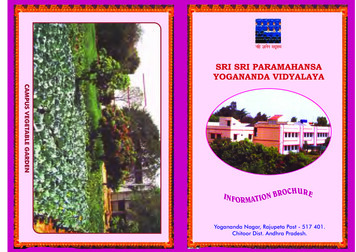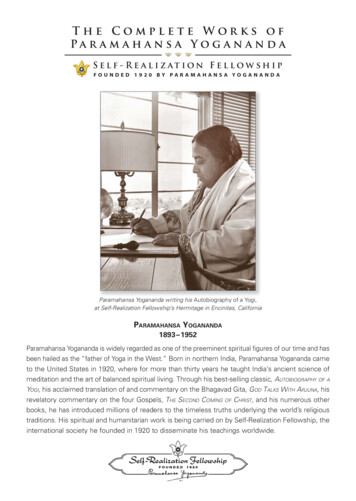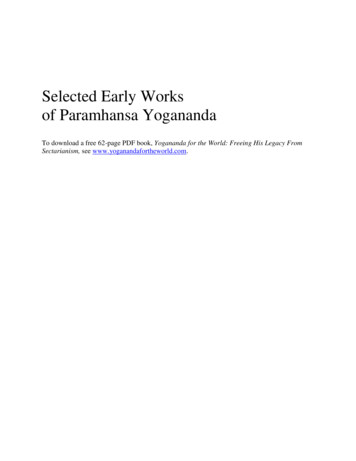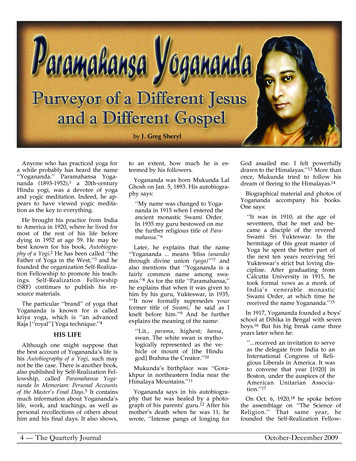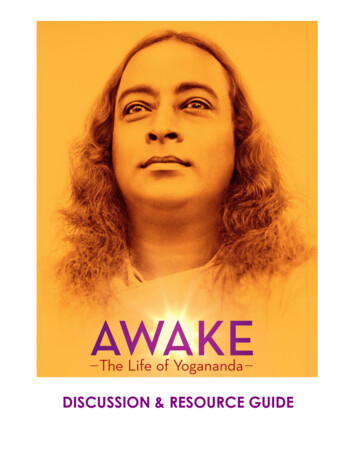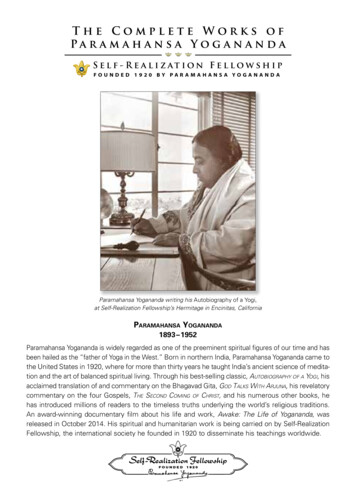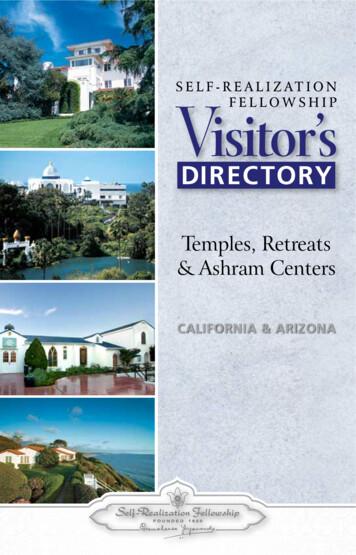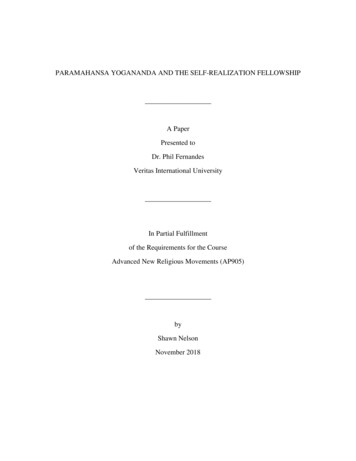
Transcription
PARAMAHANSA YOGANANDA AND THE SELF-REALIZATION FELLOWSHIPA PaperPresented toDr. Phil FernandesVeritas International UniversityIn Partial Fulfillmentof the Requirements for the CourseAdvanced New Religious Movements (AP905)byShawn NelsonNovember 2018
PARAMAHANSA YOGANANDA AND THE SELF-REALIZATION FELLOWSHIPIntroductionMost people in North County San Diego have seen the Self-Realization Fellowship inEncinitas, California. For those driving the coast on a beautiful San Diego day, it would bedifficult to miss the prominent gold Lotus Flowers that top the unusual walled towers alongHighway 101 (see photo 1). Just to the south, Swami’s Beach is a favorite surf area (photoset 2).To the north sits the Meditation Gardens, arguably one of the most beautiful garden/ocean viewsin the area (photoset 3). Yet few locals know the story behind this iconic local landmark, and itsfounder, Paramahansa Yogananda, whose name appears throughout its complex. This shortpaper is an attempt to explain who Yogananda was and what he taught. It is not an attempt torefute his teaching, but simply to show that he was a Hindu teacher, and to show what hisparticular emphases were as a counter-Christian missionary. Christians who are familiar withgood theology will see for themselves how there is nothing compatible between what Yoganandataught and biblical Christianity.About Paramahansa Yogananda (1893-1952)Yogananda’s given birth name was Mukunda Lal Ghosh. He was born in India in 1893.1His parents were followers of a Hindu guru named Lahiri Mahasaya (1828-1895) (photoset 2,G3), a yogi master who was dedicated to reviving an ancient lost form of yoga called KriyaYoga.2 This master was said to have prophesied over Yogananda when he was a nursing infantthat he would not only become a yogi like himself, but that he would be a chosen catalyst forbringing Hinduism to the West.3 In his best-selling Autobiography of a Yogi, Yoganandachronicles his spiritual quest of seeking and ultimately finding his guru Yukteswar Giri (1855-1Paramahansa Yogananda, Autobiography of a Yogi (Los Angeles, CA: Self-Realization Fellowship,2Ibid., 333, 334.Ibid., 1.2007), 4.31
21936) in India, and how he learned to master the Hindu religion under him to become a yogiguru himself. After being personally invited by the liberal Unitarian Church to come to Americain 1920 to preach on the unity of all religions, he travelled extensively throughout the UnitedStates, teaching eager American crowds his yoga religion. He had an unusual ability to captivateaudiences with his deep, melodic voice and unusual appearance. Although wildly popularwherever he travelled, he eventually began to concentrate more on the Los Angeles area wherehe felt people were more receptive to his message. Eventually, James Lynn (1892-1955), awealthy oil and insurance tycoon became a convert and bankrolled the first Self-RealizationFellowship center in Los Angeles in 1925. Ten years later, Lynn purchased the thirty-five-acrebeachfront property in Encinitas, built a hermitage and temple—all while Yogananda was awayin India—and gave it to Yogananda as a surprise gift upon his return. By 1999, the SelfRealization Fellowship would have five-hundred similar meditation centers in fifty-fivecountries.4 And it shows no signs of slowing down.Unprecedented SuccessAmericans and Europeans were already warming up to Hinduism and Buddhism throughpopular writers like Ralph Waldo Emerson and Friedrich Nietzsche5 by the time the first Hindumissionary arrived in 1893 to speak at the World’s Parliament of Religions in Chicago.6 Hisname was Swami Vivekananda (1863-1902) but he had less success because he was only in theUnited States for a few years, and then he returned home. Yogananda, on the other hand, wasthe first Hindu missionary to remain in the United States. He is a kind of “Hudson Taylor”7 forHinduism, the first long-term pioneer of an Eastern counter-Christian missionary movement. Tosay that Yogananda has had a profound impact on modern American culture is an4John Weldon, “Self Realization Fellowship,” The John Ankerberg Show, accessed November 10, ion-fellowship/.5Encyclopedia Britannica (Chicago, IL: Encyclopedia Britannica, 2016), s.v. “New Religious Movement.”6Elliot Miller, “Swami Yogananda and the Self-Realization Fellowship,” Christian Research Institute,accessed November 10, 2018, the-self-realization-fellowship/.7Hudson Taylor (1832-1905) was a very successful Christian missionary pioneer in China.
3understatement. He has had a major impact on every generation since he first set foot onAmerican soil nearly one-hundred years ago.Consider his impact on Baby Boomers, my parent’s generation. George Harrison, leadguitarist of the Beatles in the 1960s, said when someone gave him a copy of Yogananda’sAutobiography in India, the photo on the cover grabbed him (photoset 5, B):[I] just looked at the cover, and he just zapped me with his eyes If I hadn't read that, Iprobably wouldn't have a life I'd just be, you know, some horrible person with apointless life. It just gave meaning to life The Autobiography of a Yogi is the book thatI keep stacks of around the house. And I give it out constantly, you know, to people. Youknow, like when people need regrooving. Read this.8There is a photo of the most significant people who shaped modern culture on the cover of Sgt.Pepper's Lonely Hearts Club Band (1967) by the Beatles (photoset 5, C). Yogananda and allthree of his gurus (Mahavatar Babaji, Lahiri Mahasaya and Yukteswar Giri) are found minglingwith the crowd alongside others like Marylyn Monroe, H. G. Wells, Albert Einstein andSigmund Freud.My generation, Generation X, is still fascinated with Yogananda. His Autobiography of aYogi was named “100 Best Spiritual Books of the Century” in 1999 by HarperCollins. It waslauded as, “one of the most influential spiritual books of modern times.”9 It is said that “SteveJobs apparently had only one book on his iPad. Lo and behold, that book turns out to be theAutobiography of a Yogi” by Yogananda.10 Knowing he was dying in 2011, Steve Jobs plannedevery detail of his own memorial. He gave a brown box to every attendee he invited. Inside thebox was the Autobiography. Giddy attendees said Job’s last message was very clear: “Actualizeyourself.”118Awake: The Life of Yogananda, directed by Paola di Florio and Lisa Leeman (CounterPoint Films, NewYork: Kino Lorber, 2014).9Yogananda, Autobiography of a Yogi, 1.10Awake: The Life of Yogananda.11Hitendra Wadhwa, “Steve Jobs's Secret to Greatness: Yogananda,” Inc., June 21, s-self-realization-yogananda.html.
4For Millennials and Generation Z, the words yoga and meditation are now commonhousehold words. These, along with other Eastern themes, are portrayed in Disney movies,practiced in public (and even some private Christian) schools, commercials show healthy peoplepracticing them on beaches, and posters show people meditating and doing yoga in malls acrossAmerica. These practices were once foreign to America in the 1920s but are now commonplacein this once “Christian” nation. And Yogananda was one of the first to introduce us to it.Hinduism Dressed in Christian ClothesSome say Yogananda produced a Hindu-Christian hybrid.12 However, when one looks atwhat he taught, it is not proper to call it a hybrid because there is nothing of biblical Christianityleft in his teachings. It is more appropriate to say that he repackaged Hinduism in an attempt tomake it more appealing to Christians living under a Christian worldview. In missionaryterminology this is called contextualization: what he really did was contextualize Hinduism.Here are the basic teachings of Hinduism along with statements from Yogananda showing thatwhat he really embraced were Hindu beliefs.Basic Overview of HinduismGod. Hindus believe in pantheism. This is the belief that God is all and all is God.Yogananda taught that everything, including people, and even the matter of the universe (atoms),is divine.13 He wrote, “Every grain of food you eat, every breath you take, is God.”14 That is notto say that it is from God, but that it is God.Creation. The universe is said to be an illusion in Hinduism (maya). One ofYogananda’s favorite illustrations was that the universe is like a movie. God (Spirit)individualized itself through “vibratory activity” to create this world much like the rays of light12Elliot Miller.“God lives in every atom of creation.” See Paramahansa Yogananda, Scientific HealingAffirmations (Los Angeles, CA: Self-Realization Fellowship, 2011), Kindle location 882.14Ibid., Kindle location 2001.13
5from a projector are individualized onto a movie screen.15 Pure Spirit created a universe inwhich it divided itself “into many souls that they may play with Me.”16 But just like a movieultimately is not real, creation is also not real.Man. Since everything is an illusion, man, too is an illusion. Man’s true essence isdivine, and this is the gist of Yogananda’s “self-realization.” The goal is for people is torecognize that their true nature is divine and that they are actually one with God. The bloomingLotus Flowers around the Encinitas complex (photo 1) are illustrations of man realizing thisdivinity within.Sin and evil. There is no sin in Hinduism. Instead, the big problem is everything in thisworld is an illusion. This illusion makes people ignorant of their true nature: divinity.Yogananda taught ignorance is “the root-cause of all human maladies.”17 We are merely dupedinto thinking everything is real, including our pain (evil). However, “When we have finishedseeing the motion picture, we know that nobody was killed; nobody was suffering.”18 There isreally then no evil, no disease, no disharmony, no separateness. Even Satan himself is an illusion(he is taught to be symbolic).19 Hell does not exist.20 Mankind’s Fall in the Garden in Genesis 3is symbolic of falling into illusion, not falling into sin.21Karma and reincarnation. The biggest problem in Hinduism is that illusion (maya)keeps people trapped in a near-endless cycle of rebirth. Man is travelling a path of upwardevolution played out over many lives. Actions from previous lives affect subsequent ones. This15Yogananda, Autobiography, chapter 30.Paramahansa Yogananda, Journey to Self-Realization, New ed. (Los Angeles, CA: Self-RealizationFellowship, 1997), 32.17Paramahansa Yogananda, The Yoga of Jesus: Understanding the Hidden Teachings of the Gospels (LosAngeles: Self Realization Fellowship, 2007), Kindle locations 630, 631.18Yogananda, Journey to Self-Realization, 20.19Yogananda, The Yoga of Jesus, Kindle locations 327-329.20Ibid., Kindle locations 1228, 1229.21Yogananda, Scientific Healing Affirmations, Kindle locations 386-388.16
6is the law of karma. Yogananda said people work out karma through “many lifetimes ofphysical, mental, and spiritual evolution.”22 Only then can we break the cycle of rebirth.Jesus. Jesus was an ordinary man who attained “Christ Consciousness.” In other words,Jesus followed the path of “self-realization” and eventually arrived at the same knowledgeYogananda and others attained throughout history, thus achieving “Christ Consciousness.”However, Jesus was just one of many sent to help mankind throughout history (there were manyothers including Krishna, Buddha, Yogananda and his gurus).23 Jesus did not die on the cross toprovide salvation for our sins, but to be an example for us and show us the way to selfrealization.Salvation. Self-realization (not forgiveness) is what we need. Our big problem isignorance of our divinity. We must follow the example of Jesus and become like Christ,resurrect the Christ within us, and attain “Christ Consciousness” for ourselves.24 The “secondcoming” of Jesus will be when the masses finally achieve this.Yoga: Paramahansa Yogananda’s EmphasisOf course, Yogananda was a yogi who emphasized yoga. For him, yoga was a muchquicker path to attaining self-realization than other Hindu approaches.Kriya Yoga. Most Americans who practice yoga today are completely unaware that it isan ancient Hindu practice aimed at producing “union” with God (yoga means “union”).25Yogananda taught that it would normally take the average person a million years to climb theupward path of spiritual evolution to achieve self-realization.26 However, using his yogatechnique (which he named Kriya Yoga), it is taught that one can achieve this enlightenment in22Yogananda, The Yoga of Jesus, Kindle locations 929-938.Ibid., Kindle locations 263-265.24Ibid., Kindle locations 324, 325.25Ibid., Kindle locations 141, 142.26Yogananda, Autobiography, 269.23
7just three years’ time.27 The key to Kriya Yoga, according to Yogananda, is that it is directaccess to God. Other Hindu devotees seek reunification with God through personal deities(Brahma, Vishnu, Shiva, Krishna, etc.). But Yogananda taught it is far better (and faster) to havedirect experience of God through yoga union. Here’s how he said it works.Medulla oblongata. Per Yogananda, there is a point of contact between a person’s divinespirit and a person’s body. The medulla oblongata (which sits between the brain and the spinalcord) is where the contact occurs. Following Hindu teaching, he said that during creation, divineSpirit energy moved at different vibratory rates. This resulted in Spirit individualizing itself intoconscious thought, and then it further condensed to create matter, including our own bodies.28The medulla is the doorway through which the divine Spirit provided and continues to providethe energy and lifeforce of matter. Using Kriya Yoga techniques, one learns to open thisdoorway not only to commune with the divine flow, but also to release vibratory Spirit power forhealing of self and others.Directly experiencing the divine. Yogananda taught that his yoga technique was a wayfor people to have direct experience with the divine. Through it, “God can be known, not as atheological concept but as an actual personal experience.”29 By direct contact, a person canreceive intuition knowledge of God directly, which is considered far better than mere “theoreticalknowledge about” God. In yoga union, people are said to “experience direct perception of truthwithout the intermediary of the senses.”30 The divine intuition that comes from meditation notonly serves to make one aware of their divinity, but also acts as a type of soul guidance.Chanting and affirmations. Since ultimately mind (conscious Spirit) drives matter, themind has power to cure diseases.31 One can concentrate the mind to consciously increase the27Larry A. Nichols, George Mather, and Alvin J. Schmidt, Encyclopedic Dictionary of Cults, Sects, andWorld Religions (Grand Rapids, MI: Zondervan, 2006),415.28Self-Realization Fellowship, Worldwide Prayer Circle (Los Angeles, CA: Self-Realization Fellowship,1984), 7.29Yogananda, The Yoga of Jesus, Kindle locations 628, 629.30Ibid., Kindle locations 2420, 2421.31Yogananda, Scientific Healing Affirmations, Kindle locations 215, 216.
8supply of cosmic energy into a sick part of the body. It is said this can be done through positiveaffirmations made by the mind which reject the illusion of sickness. Some examples ofaffirmations from Yogananda are: “I am charming and magnetic, I am pleased with all; I wipeaway all tears and fears. I have no enemy. I am the friend of all. I have no habits, In eating,thinking, behaving; I am free, I am free.”32 Affirmations can be made for anything: materialsuccess, social success, sexual purity and curing bad habits.33 Or, they can be made for healingthings like eyes, stomach and teeth. These can be done verbally, with conscious chanting, donewhispering or done in the mind only. There is even subconscious and “superconscious” chantingwhich is said to be the deepest and most powerful.34Supporting Hinduism with the Bible?Any Christian who is familiar with even basic Christian theology will know that theabove is not consistent with Christianity. How then did Yogananda attempt to convince a largelyChristian culture that the Bible supports Hinduism?First, he said Jesus studied from gurus in India. the wise men of the East who made their way to the infant Jesus in Bethlehem were, infact, great sages of India. Not only did the Indian masters come to Jesus, but hereciprocated their visit. During the unaccounted-for years of Jesus’ life—the Scriptureremains silent about him from approximately age fourteen to thirty—he journeyed toIndia.35He continued that it was during the “lost years” that we have no mention of in Scripture thatJesus studied and achieved “Christ Consciousness.” After preaching and teaching in India, Jesusreturned to Israel to start his ministry there. Yogananda points to evidence of Jesus’ trip to India32Ibid., Kindle locations 718-723.Ibid., Kindle locations 667-794.34Ibid., Kindle locations 464-466.35Yogananda, The Yoga of Jesus, Kindle locations 340-344.33
9from supposed manuscripts found in a Tibetan monastery just over one-hundred years ago (thisevidence has since been thoroughly refuted; see footnote).36Next, he claimed Jesus imparted much deeper, secret teaching to his closest disciples.This teaching, he says, were “lost to institutional Christianity.”37 He said the extra-biblicalGnostic gospels contain a better reflection of the real teachings of Jesus. Gnosticism was one ofthe biggest challenges to the early church. And it did, in fact, teach that man had a spark of thedivine within. Through secret knowledge (gnosis) man must escape the physical world to arriveback to the divine. Yogananda appealed to these Gnostic writers by name (Basilides, Theodotus,Valentinus and Ptolemaeus) and to works like the Gospel of Thomas and the Nag Hammadimanuscripts (for a refutation of Gnosticism see footnote).38Finally, he said that the Bible has a three-fold meaning. “All Scriptures, such as theBhagavad Gita, or the Hindu Bible, and the Christian Bible, have a three-fold meaning.”39 Thereis the material, the mental and the spiritual meanings, with the spiritual meaning being thedeepest. He also said that all religions have teaching which is understood by the many (exoteric)and deeper teaching which is understood by the few or inner core (esoteric).40 Clearly, the goalis to become one of the ardent few who understand the deeper meaning of the biblical text. Thisline of thinking is the only way he can attempt to harmonize religious texts that have competingworldviews (by ignoring the plain, ordinary meaning of the author of any text and inserting hisown meaning instead).41 Consider some examples of his eisegesis below.36For a refutation, see Douglas R. Groothuis, Jesus in an Age of Controversy (Eugene, OR: Wipf & StockPub, 2002), chapters 7 and 8.37Yogananda, The Yoga of Jesus, Kindle locations 100-102.38For a refutation see Groothuis, Jesus in an Age of Controversy, chapters 5 and 6.39Paramahansa Yogananda, The Second Coming of Christ (Los Angeles, CA: Self-Realization Fellowship,2017), Kindle locations 146-148.40Yogananda, The Yoga of Jesus, Kindle location 911.41Eisegesis is reading one’s meaning into the text while exegesis is reading the author’s intended meaningfrom the text. Anytime somebody writes or speaks, they have a meaning which can be determined by the grammarof the words they used. Good Bible study and communication depends on trying to understand the author’s intendedmeaning from the text (exegesis), not forcing our own. Even Yogananda expected his readers to try to understandthe meaning of his books by means of the grammar he used.
10Man shall live by the medulla oblongata. The familiar passage from Jesus’ Temptationsays, “Man shall not live by bread alone, but by every word that comes from the mouth of God”(Mt. 4:4). Yogananda said the “mouth of God” refers to the medulla oblongata and the wordsthat proceed from it “is life energy or cosmic vibratory force.”42 What we really need for livingis not food alone but the life energy that comes from our medulla oblongata.Jesus said the light of the body is the “third eye.” Matthew 6:22: “The eye is the lamp ofthe body. So, if your eye is healthy, your whole body will be full of light.” Yogananda said thisrefers to a “third eye” that becomes visible during deep meditation, appearing in the middle ofthe forehead. This is a doorway into the presence of God.43 If this “third eye” is healthy, thenwe are full of light.The traditional Gospel message from John 3 is really about Hinduism. John 3:14-15:“And as Moses lifted up the serpent in the wilderness, so must the Son of Man be lifted up, thatwhoever believes in him may have eternal life.” He said the serpent refers to our consciousnessand life force. When we lift our consciousness up through the “passageway at the base of thespine” (medulla oblongata) we will “gradually acquire the immutable state—ChristConsciousness, the Son of God.”44Other passages, such as the Genesis account of creation is treated as pure allegory.Yogananda was taught by his guru that “Genesis is deeply symbolic, and cannot be grasped by aliteral interpretation.”45 His master went on to explain that the tree of life was actually the humanbody, the forbidden fruit was sex, the serpent is our desire for sex, and the knowledge of goodand evil is illusion (maya).42Yogananda, Scientific Healing Affirmations, Kindle locations 199-203.Yogananda, The Yoga of Jesus, Kindle locations 1340-1344.44Ibid., Kindle locations 1181-1184.45Yogananda, Autobiography, 191.43
11Reasons for SRF SuccessYogananda had to do some severe scripture bending to get Hinduism to fit into theChristian Scriptures. Why then was he so successful in a “Christian” culture? Here are somelikely reasons.Charisma. It has already been mentioned that Yogananda had unusual charisma whichmany found appealing. When he arrived in America in 1920, most Americans had never seen aHindu guru.46 He was short, unusual in appearance, and did not dress like an American but as hedid back home. “He looked strange, like a woman with long hair. But I remember his powerfuleyes.”47 His unusual appearance was matched by his unusual ability to spell-bind audiences. Hewas a very eloquent speaker with incredible charm. His voice was deep and melodic as he spoketo spellbound crowds about an unusual message (inner divinity).Spectacular stories. His Autobiography is filled with many stories that seem to addcredibility to his message.48 It is filled with supposed miraculous healings, levitation, thesending of telepathically messages, mind-control, bodies and buildings that materialize anddematerialize, timeless shape-shifting gurus, people who no longer require food to survive,people resurrected from the dead, visions of the future, and encounters with Jesus himself.Highly evangelistic. Yogananda was a missionary who wanted Hindu converts. This toppriority is evident in his speaking and writing. He geared his books towards ordinary Americans.His wrote clearly and his books are easy-to-read. He attempted to support his beliefs withscience. He was sure to include invitation for further study in every book and pamphlet. Heincluded testimonies wherever possible. Here are some examples: “The Lessons have46As mentioned, there was one prior Hindu missionary before him. Swami Vivekananda visited briefly in1893. But Paramahansa was the first missionary to stay permanently in the United States.47Ravi Shankar, famous sitar Indian musician, in Awake: The Life of Yogananda.48Space limitations prevent answering his miracles from a Christian perspective. In short, it is my beliefthat many of Yogananda’s “miracles” and visions were either psychologically induced, false or involve demonicforces at work. For more info about this see Norman Geisler, Signs and Wonders (Eugene, OR: Wipf and StockPublishers, 1988), chapter 7.
12transformed my life as no other writings have.”49 “I have been a student of the Self-Realizationteachings just one year and my life has completely changed. My health has improved 100%.”50And “The year with SRF has brought me more peace and spiritual wisdom and answers toproblems than time spent in any other practice.”51Polemical. Yogananda was very much interested in attracting seekers. But he was notshy about speaking out against organized Christianity. He said the only thing the Christianchurch has produced is “unprofitable speculations” about God.52 He called church dogma“theological debris.”53 He said Jesus is so misunderstood today by modern Christians that he “isnow being crucified by ignorant people.”54 True Jesus-followers are those who meditate andaren’t the results of “intellectual theological seminaries.”55 We must not be “satisfied withsermons, ceremonies, organizations, and festivities.”56 What good is “church membership” and“outer ritual” while “never knowing him in reality by contacting him in meditation”? 57 Do wewant to be “real Christ-ians” or “just members of Christian churchianity?”58 Yoga is not “atheological concept” but “actual personal experience.”59 Statements like these have strong appealto those who are turned-off by organized religion and bad-church experiences.Practical. As a master-Hindu-evangelist Yogananda targeted the practical needs of allpeople. He commonly said things like, “What human being has not longed to understand themeaning of existence, to fathom the ultimate purpose of creation? We all want to experience49Self-Realization Fellowship, Undreamed-Of Possibilities: An Introduction to Self-RealizationFellowship (Los Angeles, CA: Self-Realization Fellowship, 1982), 32.50Ibid.51Ibid.52Yogananda, Autobiography, 362.53Ibid.54Yogananda, The Second Coming of Christ, Kindle locations 120, 121.55Ibid., Kindle locations 307-309.56Ibid.57Yogananda, The Yoga of Jesus, Kindle locations 298, 299.58Ibid., Kindle locations 320-322.59Ibid., Kindle locations628, 629.
13lasting satisfaction and perfection, but is it really possible?”60 He then presented yoga union asthe way to inner fulfillment: “In truth, all the knowledge, creativity, love, joy, and peace we arelooking for are right within us, the very essence of our beings.”61 One pamphlet I found at theMeditation Garden (photoset 3, C) offers prospects “Step-by-step instruction ” on topics like“Friendship—the art of getting along with others; creating harmony in marriage and family life;finding your true vocation and balanced success and prosperity; yoga methods of diet,healing, relaxation, and rejuvenation; living without stress and fear; “life after death.”62 It isno wonder why Yogananda drew followers from all walks of life: “prominent businessmen,judges, lawyers, even hardened journalists.”63ConclusionThe purpose of this paper was not to refute Yogananda and the Self-RealizationFellowship teaching per se; it was simply to make people aware of what the Self-RealizationFellowship and its founder believes. Yogananda said he was revealing true Christianity to theWest. But as was shown here, his Hindu message is not compatible at all with Christianity.Yogananda and his Self-Realization Fellowship have dramatically influenced our culture,moving us away from biblical Christianity by forcing a Hindu interpretation upon the biblicaltext.60Self-Realization Fellowship, Undreamed-Of Possibilities, 3.Ibid.62A card inserted into Ibid.63Awake: The Life of Yogananda.61
14Appendix 1: Photos of Self-Realization Fellowship, EncinitasPhoto 1: Golden Lotus Flowers top the towers along Highway 101,symbolic of a person’s journey into self-realization (“Christ consciousness”).Photoset 2: Swami’s Beach (A), just to the south of the Self-RealizationFellowship in Encinitas. Buildings for retreat-goers and resident hermits can be seen beyond theEaster Island Heads (B). A walk through the Lotus Flower stairway (C) leads to the beachbelow, a favorite surf spot (D) in San Diego.
15Photoset 3: The Meditation Garden (A) is arguably one of the nicest gardens in the area. It hasocean views (E), koi ponds (B), mini-waterfalls and a succulent garden (D). Notice the literaturestation (C) which has material for proselytizing visitors.
16Photoset 4: The Self-Realization Fellowship Bookstore (A) reveals that what Yogananda broughtto the United States was nothing other than Hinduism. In addition to clothing (H), various Hindugods are available for purchase (B) including Krishna (D) ( 4,900), Shiva (E) ( 1,000), Buddhaand Ganesh (F). The album (G) in the reading room (C) shows Jesus among many otherenlightened ones. From left to right they show Babaji (G1), Jesus (G2), Lahiri Mahasaya (G3),Krishna (G4), Yukteswar Giri (G5) and finally Paramahansa Yogananda (G6).
17Photoset 5: Yogananda had an ability to draw and captivate large crowds. Yogananda’s firstnight teaching in Los Angeles (1925) drew 6,000 people (A), twice the capacity of thePhilharmonic Auditorium. His best-selling Autobiography of A Yogi (B) was the only book SteveJobs had on his iPad; he prearranged to give a copy to all he invited to his memorial. All fourSelf-Realization Fellowship gurus are found on the album cover for Sgt. Pepper's Lonely HeartsClub Band by the Beatles: Yukteswar Giri (C1), Babaji (C2), Lahiri Mahasaya (C4) andParamahansa Yoganda (C3) are present with other cultural icons like Marylyn Monroe andAlbert Einstein.
18BibliographyAwake: The Life of Yogananda. Directed by Paola di Florio and Lisa Leeman. CounterPointFilms. New York: Kino Lorber, 2014.Encyclopedia Britannica. Chicago, IL: Encyclopedia Britannica, 2016.Geisler, Norman. Signs and Wonders. Eugene, OR: Wipf and Stock Publishers, 1988.Groothuis, Douglas R. Jesus in an Age of Controversy. Eugene, OR: Wipf & Stock Pub, 2002.Miller, Elliot. “Swami Yogananda and the Self-Realization Fellowship.” Christian ResearchInstitute. Accessed November 10, 2018. he-self-re
About Paramahansa Yogananda (1893-1952) Yogananda’s given birth name was Mukunda Lal Ghosh. He was born in India in 1893.1 His parents were followers of a Hindu guru named Lahiri Mahasaya (1828-1895) (photoset 2, G3), a yogi master who was dedica
